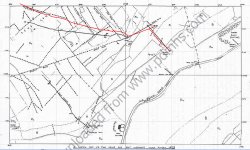History Trog
Member
Some time ago, I wrote up a detailed history of the Bonsall Leys Mining Company but didn't get round to finishing it off because of being overwhelmed by research for the Matlock book.
All the material from the No.2 Level was taken out of the adit. Much of the limestone was sold at 6d per ton - hardly economic though. Miners simply tolerated cramped working conditions - think of coffin gate levels. There was no lower level linked with it.
The longest drive done by the company was of course the No. 3 Level which ranged from the road side and beneath Parish Quarry. By the time I got on the scene (c1966) this had collapsed beneath the quarry floor but Nellie Kirkham's papers include a good survey by Doug Nash and Op Mole. It was heading for the Horsedale Mines but was a similar complete failure - I made its recorded driveage (not including side passages) as 2298 feet.
Prosperous Mine was a subsumed into the Slaley Sough Title. It may have exploited a small rich pipe on top of the lava flow. There may have been a feeling that there must be some rich deep deposits on the south side of Bonsall Moor comparabel to Gorseydale and Slack mines on the north side.
All the material from the No.2 Level was taken out of the adit. Much of the limestone was sold at 6d per ton - hardly economic though. Miners simply tolerated cramped working conditions - think of coffin gate levels. There was no lower level linked with it.
The longest drive done by the company was of course the No. 3 Level which ranged from the road side and beneath Parish Quarry. By the time I got on the scene (c1966) this had collapsed beneath the quarry floor but Nellie Kirkham's papers include a good survey by Doug Nash and Op Mole. It was heading for the Horsedale Mines but was a similar complete failure - I made its recorded driveage (not including side passages) as 2298 feet.
Prosperous Mine was a subsumed into the Slaley Sough Title. It may have exploited a small rich pipe on top of the lava flow. There may have been a feeling that there must be some rich deep deposits on the south side of Bonsall Moor comparabel to Gorseydale and Slack mines on the north side.




